AR-15 derivatives are not unusual in straight-pull, single-shot chamberings, and neither are .22 LR semi-automatic builds, but combining fast-fire capability with more muzzle energy is a narrow corridor in UK law. The classic .22 WMR cartridge (from which the .17 HMR descends) is the largest rimfire cartridge. To all intents and purposes, it’s just a faster .22 rimfire. Similar bullet weights around 30-40gr are available in both supersonic and subsonic formats, with soft lead or copper-jacketed projectiles. Rimfire is the only semi-auto option in the UK and this .22 WMR is about as heavy hitting as such a gun can get.
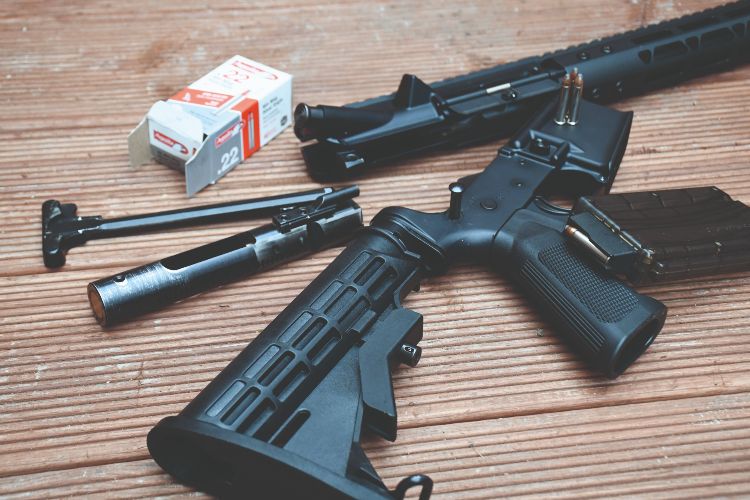 Guncraft manufacture in the UK, and from the very start pushed for total process control with the tightest manufacturing tolerances and specific attention to minor details. AR-15s of all variants fundamentally trace their design to mass-produced military rifles, and although conversion to a straight-pull .223 is relatively simple, with mainly the gas system neutered and a handle attached to the bolt carrier, the reciprocating blowback action for rimfire cartridges, which are allowed to maintain semi-automatic operation, is a harder target. There is very little spare energy to operate the gun, and what is used is effectively being bled off at the expense of internal ballistic efficiency and consistency.
Guncraft manufacture in the UK, and from the very start pushed for total process control with the tightest manufacturing tolerances and specific attention to minor details. AR-15s of all variants fundamentally trace their design to mass-produced military rifles, and although conversion to a straight-pull .223 is relatively simple, with mainly the gas system neutered and a handle attached to the bolt carrier, the reciprocating blowback action for rimfire cartridges, which are allowed to maintain semi-automatic operation, is a harder target. There is very little spare energy to operate the gun, and what is used is effectively being bled off at the expense of internal ballistic efficiency and consistency.
Guncraft use 7075-T6 aluminium for the upper and lower action halves, with precision-fit hinge/locking pins to hold the two together. They are paired at manufacture with tight fit tolerances so that there is no play at all between the two. ARs are easily customised externally, and the three major ergonomic contact points seen here are a 12" KeyMod free-floating handguard with full-length Picatinny rail. The buttstock is a six-position telescoping unit with length of pull from 260mm/10.25" to 340mm/13.5", so it will fit most shooters. The A2 polymer grip shows a rib stud to separate your index and middle fingers.
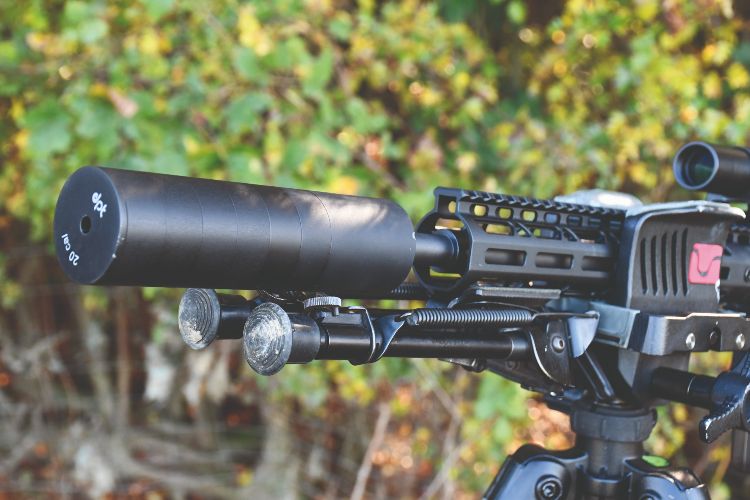 Barrel options are 12/14/16 or 18" (305/355/406/458mm), medium 21mm contour with a 15.6mm spigotted muzzle diameter. A muzzle brake/flash hider is supplied with the rifle, securely anchored with a locknut on the ½"x28 TPI threaded muzzle. The option to change to a sound moderator is inviting and I did so almost immediately for a couple of reasons – noise suppression and retention of back pressure in the barrel.
Barrel options are 12/14/16 or 18" (305/355/406/458mm), medium 21mm contour with a 15.6mm spigotted muzzle diameter. A muzzle brake/flash hider is supplied with the rifle, securely anchored with a locknut on the ½"x28 TPI threaded muzzle. The option to change to a sound moderator is inviting and I did so almost immediately for a couple of reasons – noise suppression and retention of back pressure in the barrel.
Although disassembly of the action shows a lot of detail, the principle of operation is fundamentally very simple. When the firing pin hits the cartridge rim and ignites the charge, the bullet is pushed forwards down the barrel until it is expelled from the crown. The simple laws of physics require this to be restrained at one end and it is, but only by a coil spring and the inertial mass of the bolt. There isn’t a rotary locking carrier like on a centrefire AR.
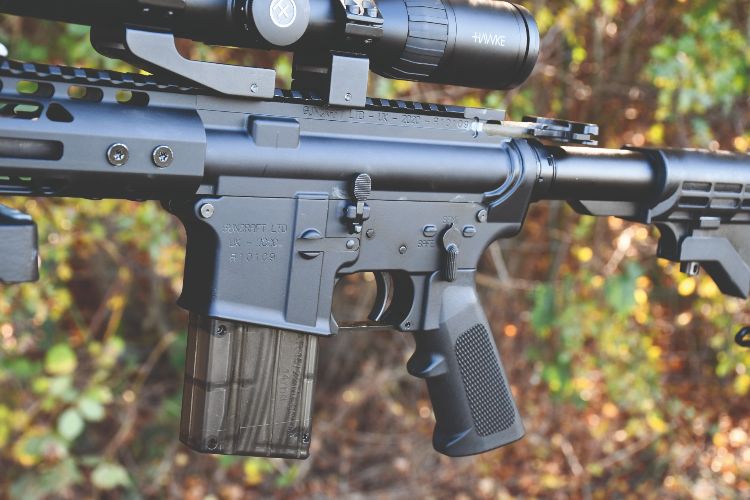 So it’s all about balance. You need enough resistance to propel the bullet yet, enough compliance to let the bolt blow back against its return spring and recock the hammer. Then after it hits its mechanical stop it has to return forward to battery, strip a fresh round from the magazine and chamber it ready to fire.
So it’s all about balance. You need enough resistance to propel the bullet yet, enough compliance to let the bolt blow back against its return spring and recock the hammer. Then after it hits its mechanical stop it has to return forward to battery, strip a fresh round from the magazine and chamber it ready to fire.
It sounds simple, and it generally is. But consistency of operation with minimal frictional interruption is fundamental for reliable cycling, as well as for the accuracy of the rifle, which needs to have a consistent internal barrel pressure for minimal velocity spread.
The bolt itself weighs a stout 417g with balancing masses to tune the rifle’s operation. That’s a fair bit of inertia to overcome before the bolt actuates a spring running within the buffer tube. Operation of this fully metallic semi-auto feels like a true .223 AR-15, with notable spring tension when first cocking the action with the non-reciprocating T-handle.
Guncraft’s upper retains the forward-assist button, adding to the authentic looks, along with a sprung dust cover that protects against dirt ingress when clicked into position. It automatically opens as soon as the bolt moves, allowing spent brass to eject. Rearward bolt travel exposes the fixed ejector on the left internal receiver wall, and the extractor claw itself has recently been customised for greater durability. The action dimensions are still based around the larger .223/5.56 NATO cartridge. I have visited Guncraft’s London workshops and was certainly impressed with the attention given to these subtle points.
The magazine system has been adapted for the .22 WMR with 3D printed feed lips that, although lowering capacity from 14 to 13 rounds, ensure reliability. This is not hobby-grade 3D printing and finished products are almost indistinguishable from injection mouldings, the tooling cost for which is prohibitive for low-volume manufacture.
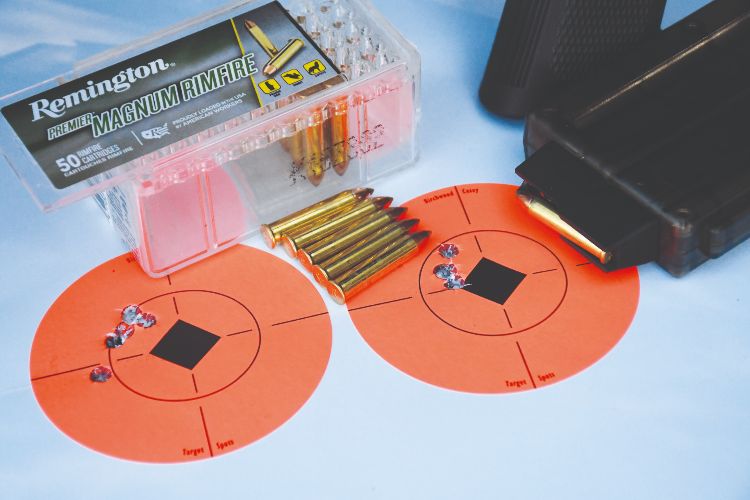 The magazine loads in a single column with a custom follower and works perfectly. It’s also nice not to get lead-stained thumbs with jacketed ammo in a WMR, unlike a .22 LR. The follower also works as a last-round hold-open for the bolt, but Guncraft recommend manually locking the bolt rearward before dropping the magazine out to minimise unnecessary wear on the follower. Other controls are a familiar push button on the right side for magazine release, with a left side vertical bolt lock/release lever and two-position safety catch above the grip’s left side.
The magazine loads in a single column with a custom follower and works perfectly. It’s also nice not to get lead-stained thumbs with jacketed ammo in a WMR, unlike a .22 LR. The follower also works as a last-round hold-open for the bolt, but Guncraft recommend manually locking the bolt rearward before dropping the magazine out to minimise unnecessary wear on the follower. Other controls are a familiar push button on the right side for magazine release, with a left side vertical bolt lock/release lever and two-position safety catch above the grip’s left side.
The rifle was delivered with a recommendation for use with 40gr .22 WMR ammo to assure semi-auto consistency, but I couldn’t get any locally. I did have 40gr lead hollow-point subsonic and some Remington 33gr high velocity. Rob at Guncraft suggested this might work with a moderator in place as they slightly extend the ‘dwell time’ of barrel pressure, just like a longer barrel would. He was right. I used a DPT moderator that allowed the gun to cycle reliably with good performance, just over the MOA standard for five rounds on target at 2062fps/312ft-lb of energy.
The trigger has a 2300gr/80oz breaking weight with minimal creep. It was consistent and predictable. There are no iron sights fitted, but with an extended rail, mounting a 1-6x24 scope was straightforward for consistent aiming.
I enjoyed shooting this less-common rifle – in fact it was only my third-ever .22 WMR. I added a stud to the forend for a bipod from which I shot the test targets prone, and I also shot freehand as well as tripod-mounted shots, where the assured free float of the barrel is never compromised by the octagonal forend. All the aluminium shows matt-black hard anodising and, although I’m always careful with rifles, this used gun showed no marks or abrasion to suggest anything other than durable finishing.
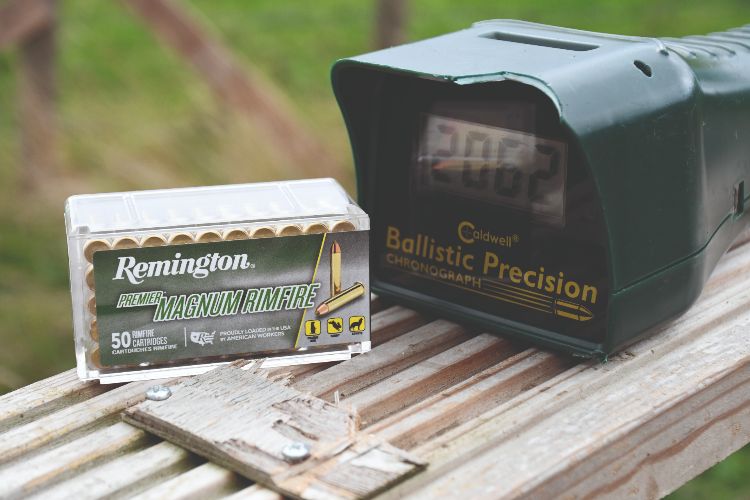 When I visited the Guncraft workshop I managed to leave with some 40gr Aguila jacketed ammo. This was the suggested favourite and although I had been lucky so far, I wanted to see if it made any difference. When fired, the noise of the recoil spring in the buffer tube under your cheek is the characteristic sound of any AR, and when I shot the 40s I got the distinct feeling that operation was a little more defined. It still operated comfortably with 1868fps/310ft-lb, but with a slightly altered timbre. The Remington 33gr was perfectly adequate, but the Aguila 40gr beat the MOA standard, which for a semi-auto rifle with a 6x scope is testament to the mechanics.
When I visited the Guncraft workshop I managed to leave with some 40gr Aguila jacketed ammo. This was the suggested favourite and although I had been lucky so far, I wanted to see if it made any difference. When fired, the noise of the recoil spring in the buffer tube under your cheek is the characteristic sound of any AR, and when I shot the 40s I got the distinct feeling that operation was a little more defined. It still operated comfortably with 1868fps/310ft-lb, but with a slightly altered timbre. The Remington 33gr was perfectly adequate, but the Aguila 40gr beat the MOA standard, which for a semi-auto rifle with a 6x scope is testament to the mechanics.
After a few hundred rounds I stripped the gun to see what was going on inside a fundamentally ‘dirty’ environment. There was none of the usual rimfire lead/lube paste impacted all over the breech face. All that fouls the action are fine particles of burnt propellant residue.
If you are an AR fan and have need for one in fast, dynamic target-orientated scenarios, this is well worth a look. It will work for pest control or foxing, and thousands of foxes have been shot with the .22 WMR over the decades. But bear in mind that, smooth as it is, the mechanical bolt and particularly the spring operation do create additional noise.
Interestingly, in general it’s usually best to let semi-autos close under their own spring tension/speed, but when I used this rifle with individually cycled subsonic rounds it was quiet and never failed to chamber or ignite a round when closed gently. There was obviously insufficient gas pressure to agitate the bolt even slightly. This was the third type of ammunition I had tried, and although it wasn’t specifically designed for semi-automatic use it was perfectly reliable in this rifle. This was yet another factor to reassure me of the precision with which this gun is made and its capability, even when deliberately pushed outside its intended realm.
Tech specs
- .22 WMR
- Sassen 14" button rifled barrel with 1:14 twist rate, threaded ½" x 28 TPI
- 12", 16" and 18" barrels also available
- 7075-T6 aluminium upper and lower receivers
- Mil-spec upper and lower receiver
- Integral M1913 Picatinny rail
- Six-position telescopic stock
- 1 x 13 round magazine
- A2 muzzle brake/flash hider supplied
- 9" or 12" KeyMod free-float handguard with Picatinny rail on top
Contact
www.Guncraftltd.co.uk
Also used